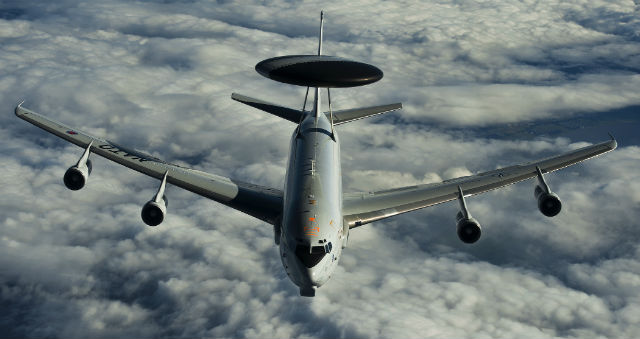Too much demand is being placed on NATO’s Airborne Warning and Control System (AWACS) to provide information, surveillance and reconnaissance (ISR) data to the alliance, despite its primary roles of command and control and battle management, a leading figure on the programme has revealed.
NATO operates 17 Boeing E-3A Sentry airborne early warning and control aircraft – supported by 16 partner nations – but because NATO has “no organic ISR assets” to utilise, the aircraft is being too often called upon to provide ISR capabilities to the alliance, Air Cdre Ian Teakle, deputy commander of the NATO AEW&C Command, told the Airborne ISR and C2 Battle Management conference in London.
This, he says, is in spite of the radar’s lack of sophistication in comparison with other aircraft’s sensing capabilities, and is as a result of a lack of alternatives being offered by the alliance.
When NATO bolstered its support of its eastern states following the rise in aggression from Russia, an ISR platform was required to operate in the region – alongside the strike aircraft that have performed policing missions over the Baltic states – but no country offered a national asset for the cause, so the E-3A had to carry out the ISR.
“Whether it was the right platform is debatable, but it was the only platform, and availability and readiness was important,” Teakle notes. “AWACS is very important, but it isn’t the right sensor for this. It is not actionable intelligence.”
Within NATO’s Joint ISR area, the AWACS aircraft is a “small sensor within, but a critical command and control and management asset”, Teakle notes.
He admits that the deployment of the Sentry in Eastern Europe is as much about providing a presence as information gathering. NATO is anticipating the delivery of the Northrop Grumman Global Hawk high-altitude, long-endurance unmanned air vehicle for its Allied Ground Surveillance effort later in 2015, which Teakle says would have been ideal for the ISR mission.
The Northrop Grumman E-2D Advanced Hawkeye can receive transmit data, but not imagery, as it “can’t get pipes big enough into the platform”, and NATO will not integrate anymore sensors on board to make it more ISR-ready.

US Air Force
Financial restraints on the AWACS provision are also affecting the programme. As it stands, only 14 of the 17 aircraft that are in service are expected to be upgraded to take the aircraft out to 2025; one of the 17 is due to retire in June 2015, while it is assumed that the other two that are not touted for upgrade will also retire before 2018.
Canada, which was the third-largest contributor, has withdrawn from the NATO AWACS effort, which led to the decision to only upgrade 14 of the aircraft.
Whether the aircraft will be operated past 2025 out to 2035 is dependent on a commitment from the member nations to fund further upgrades, a decision on which is expected to be made by 2016.
Sentry receives some €250 million ($263 million) a year in operational and support costs, which only allows for 65% of the required flying hours for the aircraft.
“There is a lot we’d love to do with this aeroplane, but the money is just not there,” Teakle notes. “The decision [on programme extension] will have to be made next year, and the 16 nations will have to decide what they are willing to spend.”
Source: FlightGlobal.com



















